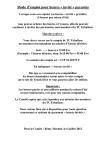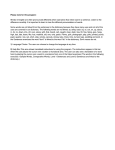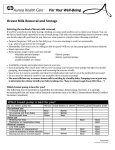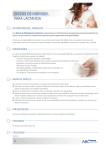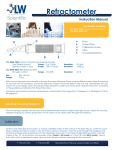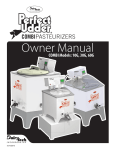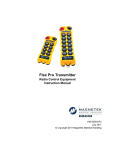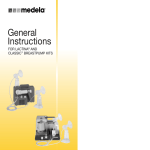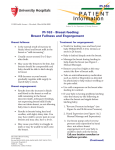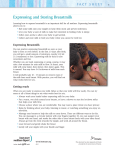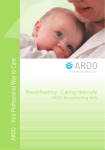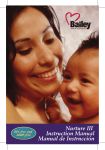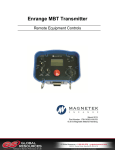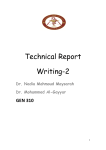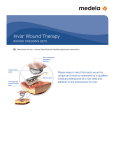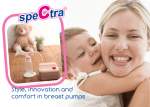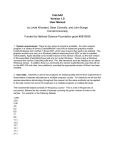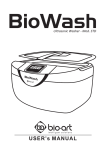Download TS-Engorgement ENG 5/00
Transcript
Breast Engorgement Prevention & Treatment During the first week after delivery, as the colostrum is changing to mature milk, your breasts will become full. This normal postpartum fullness usually diminishes within 3–5 days. Engorgement may develop if your baby does not adequately remove the milk from your breasts. During this time, your breasts will feel hard, painful and hot. Prevention You can prevent engorgement by: ■ Breastfeeding your baby frequently, 8–12 times in 24 hours. ■ Avoiding supplements of water or formula for the first 3–4 weeks unless medically indicated. ■ Expressing your milk, if you miss any feedings. ■ Weaning your baby, over a gradual period. ■ If your baby can’t latch on or your nipples are flattened, use a hospital-type electric breast pump or hand expression to express some milk which will help to soften the areola. Use moist heat and breast massage before pumping. Continue pumping every 2 hours, 10 minutes per side, until your baby can latch on. ■ If your nipples remain flat, wear multiple holed breast shells for half an hour before breastfeeding. This will help draw out your nipple, making it easier for the baby to latch on. Discontinue usage if discomfort occurs. ■ Avoid bottles, pacifiers and nipple shields during this engorgement period. These may cause nipple confusion/preference. Treatment Manual Expression of Breastmilk ■ Apply a hot, moist towel (or disposable diaper) to your breasts for 2–5 minutes, or take a hot shower before nursing your baby. ■ If your breasts are severely swollen and engorged, try applying icy cold compresses, or cold cabbage leaves, prior to nursing. ■ Hand express some milk to soften the areola after using moist heat. This makes it easier for baby to attach to the breast. ■ Use gentle breast massage before and during breastfeeding or pumping. ■ Use deep breathing, soft music or other techniques to relax before and during nursing. ■ Try applying icy cold compresses to your breast after nursing to relieve the discomfort and decrease swelling. ■ If your baby takes only one breast, use a hospital-type automatic electric breast pump or hand expression to express the milk from the other breast during the engorgement period. Marmet Technique Draining the Milk Reservoirs 1. Position the thumb (above the nipple) and first two fingers (below the nipple) about 1” to 1-1/2” from the nipple, though not necessarily at the outer edges of the areola. Use this measurement as a guide, since breasts and areolas vary in size from one woman to another. Be sure the hand forms the letter “C” and the finger pads are at 6 and 12 o’clock in line with the nipple. Note the fingers are positioned so that the milk reservoirs lie beneath them. • Avoid cupping the breast. 1 Correct Positioning Incorrect Positioning medela ® 2. Push straight into the chest wall. • Avoid spreading the fingers apart. • For large breasts, first lift and then push into the chest wall. 3 2 Push into Chest Wall 3 Roll 1. Do not squeeze the breast, as this can cause bruising. 2. Avoid sliding hands over the breast, as it may cause painful skin burns. 3. Avoid pulling the nipple and breast, which may result in tissue damage. Finish Roll 3. Roll thumb forward as if making a thumbprint and change finger pressure from middle to first finger at the same time. This rolling motion compresses and empties milk reservoirs without injuring sensitive breast tissue. Note the moving position of the thumb and fingernails as shown in the illustration. 4. Repeat rhythmically to completely drain reservoirs. • Position, push, roll... Position, push, roll... 5. Rotate the thumb and fingers to milk other reservoirs, using both hands on each breast. Right hand Avoid These Motions Left hand Squeeze Slide Pull Assisting The Milk Ejection Reflex Gentle Massage 1. Massage the milk producing cells and ducts by pressing the breast firmly with the flat of the fingers into the chest wall, beginning at the top. Move fingers in a circular motion, concentrating on one spot at a time for a few seconds before moving on to another spot. Spiral around the breast toward the areola as you massage. The motion is similar to that used in a breast examination. 2. Stroke the breast area from the top of the breast to the nipple, using a light tickle touch. Continue the stroking motion to help you relax, which in turn will stimulate the milk ejection reflex. 3. Shake the breast while leaning forward so that gravity will help the ejection reflex. Marmet Technique copyright 1978, revised 1979, 1981 and 1988. Used with permission of Chele Marmet and The Lactation Institute, 16430 Ventura Blvd., Suite 303, Encino, California 91436 Phone 818-995-1913. To locate Medela Products or a breastfeeding specialist in your area, call 1-800-TELL YOU, 24 hours a day, 7 days a week. Medela, Inc., P.O. Box 660, McHenry, IL 60051-0660 USA Medela, Inc., 4090B Sladeview Crescent, Unit 2, Mississauga (Ontario) L5L 5Y5 CANADA Phone 1-800-435-8316 or 1-815-363-1166, Fax 1-815-363-1246 www.medela.com email: [email protected] Medela is a registered trademark of Medela. Contributions made by Pat Bull, RN, IBCLC and Jan Barger, RN, MA, IBCLC; The Breastfeeding Connection. Permission granted by Medela Inc. to photocopy for non-commercial purposes. 1937017 A 0500 ©Medela, Inc. All rights reserved. medela ®


